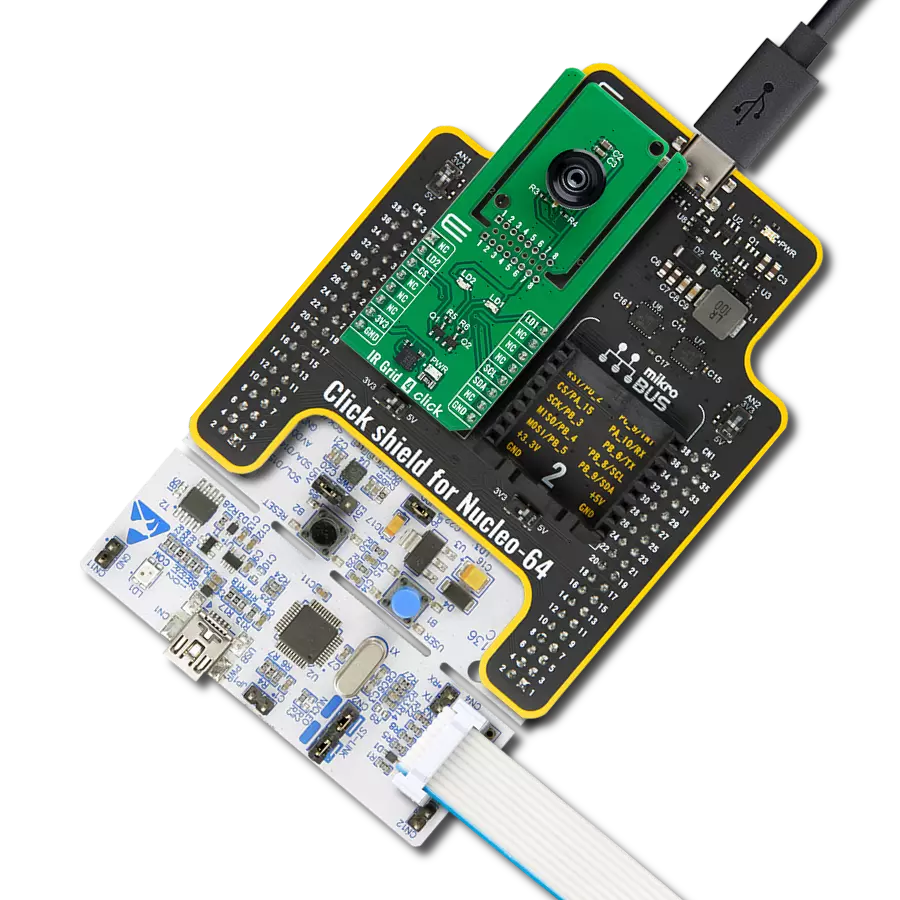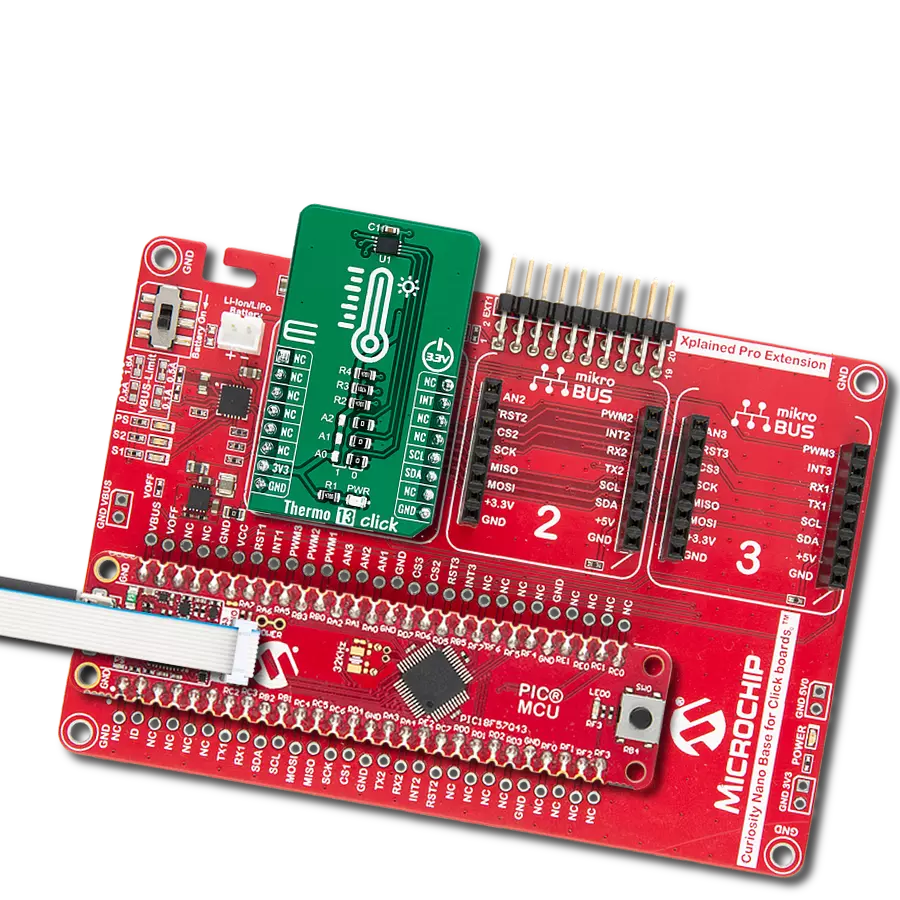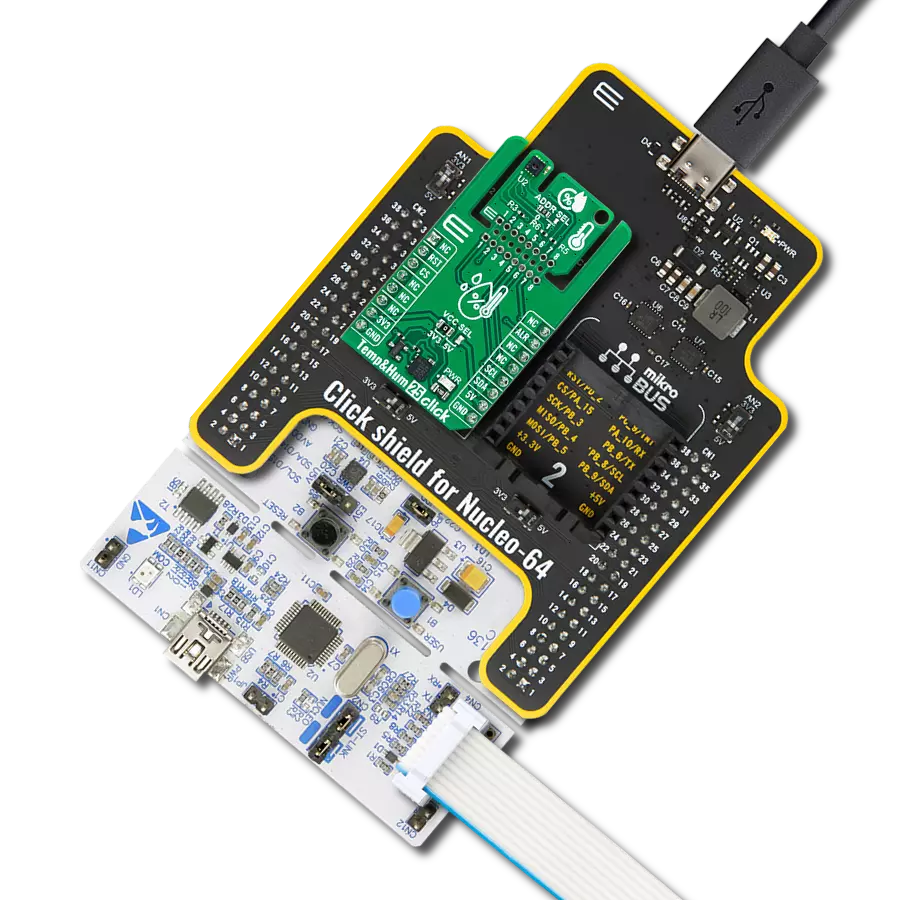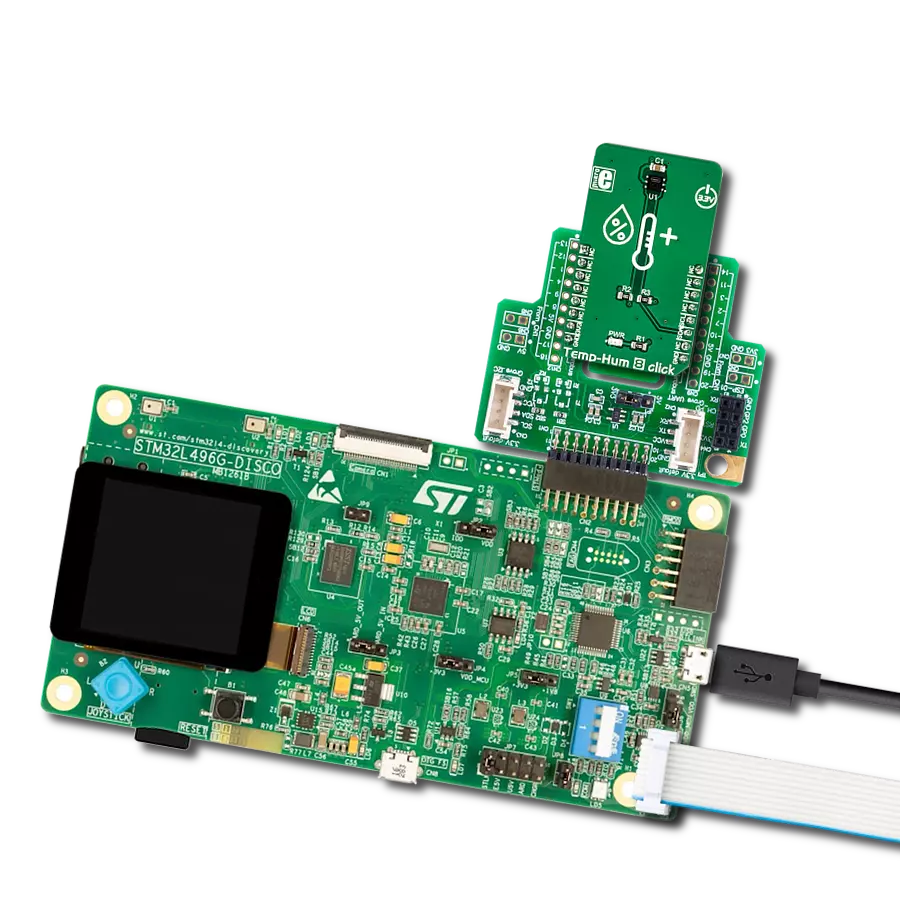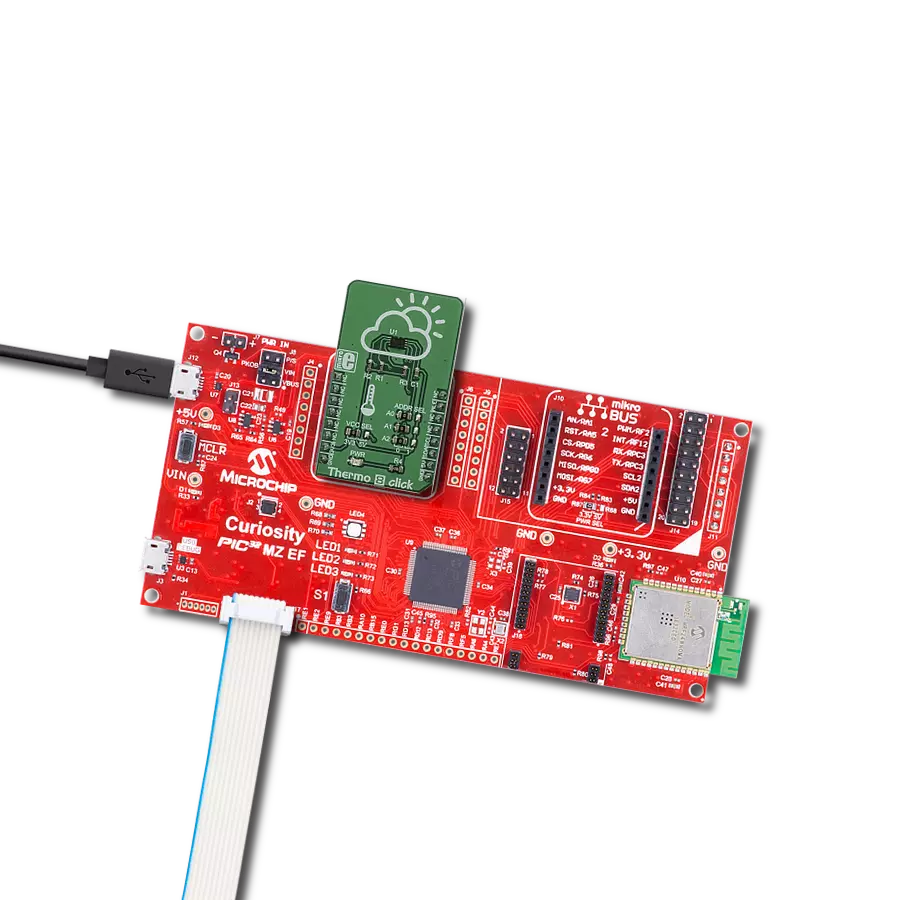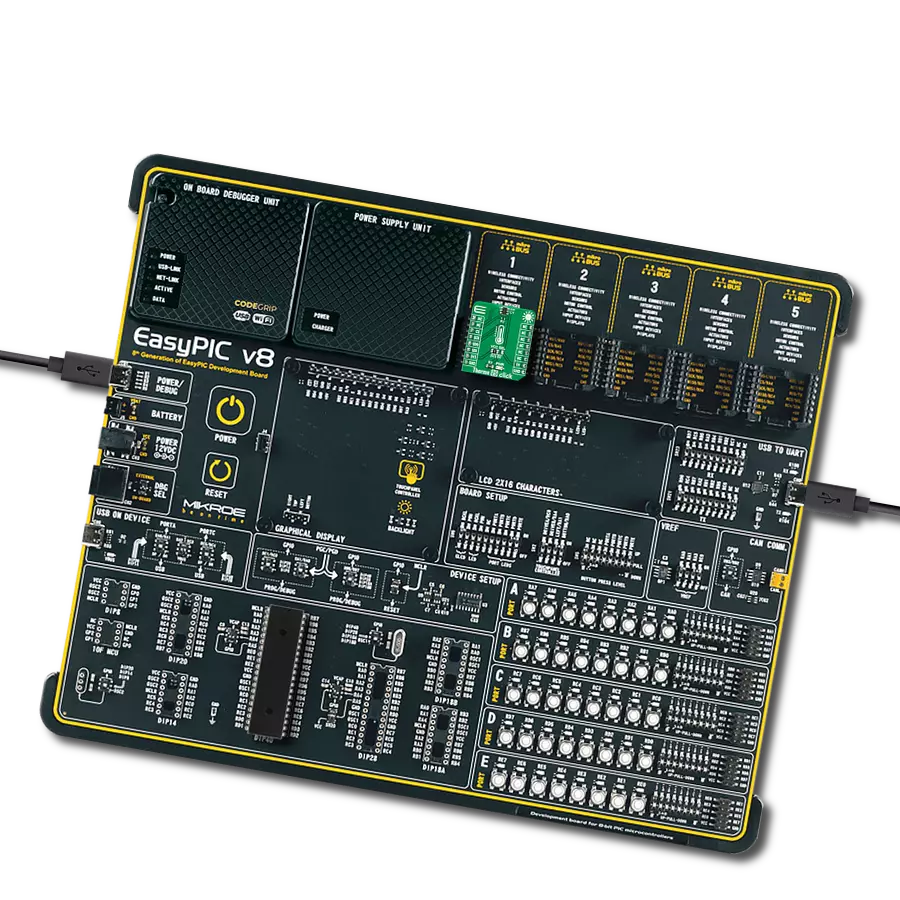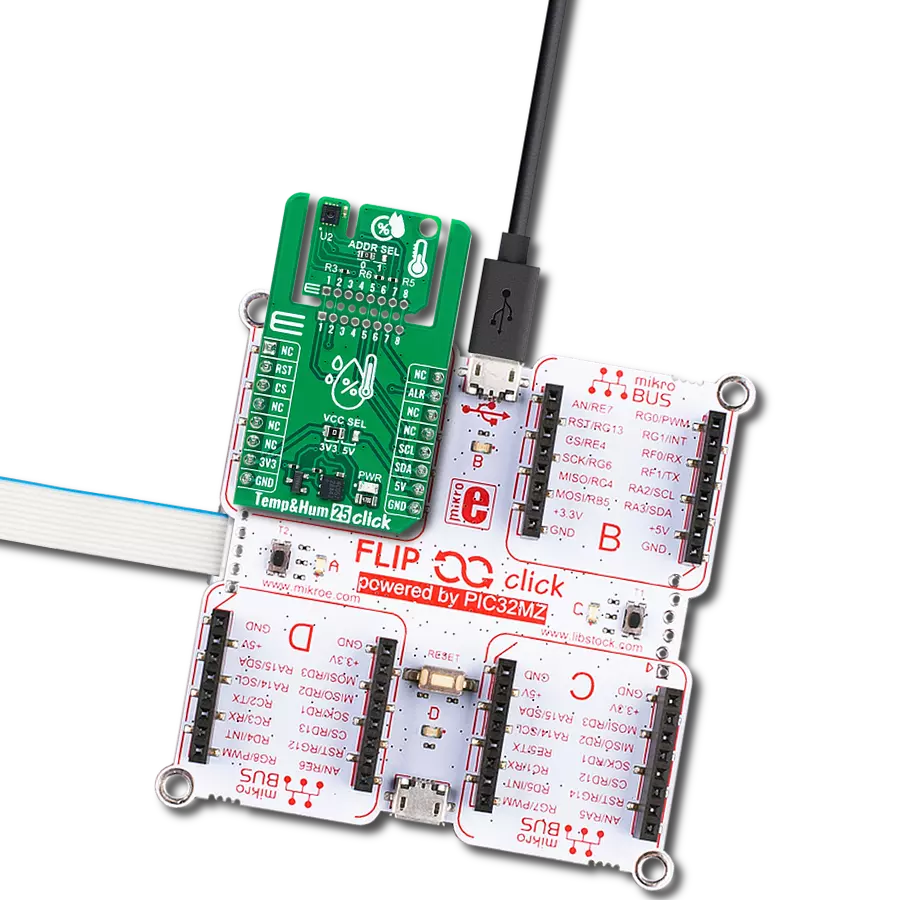Our moisture detection solution takes the guesswork out of skincare, enabling you to maintain healthy, glowing skin with precise hydration analysis at your fingertips.
A
A
Hardware Overview
How does it work?
Moisture Click is based on the FDC2112, a very precise 12bit capacitance to digital converter, from Texas Instruments. The working principle of the Moisture Click is based on measuring the skin capacitance property in order to determine the skin moisture level or hydration state of the outer epidermis. The studies show that various skin hydration measurement methods are complementary and no single method gives 100% accurate result for all skin conditions. However, measurement of the capacity turned out to be the most effective and reliable of measuring the skin hydration. The main challenge for all the capacitive sensing applications is the presence of EMI and noise, which can reduce the sensitivity. The FDC2112 IC employs an innovative narrow band architecture, which reduces the electromagnetic interferences (EMI) and noise influence. It uses an L-C resonator, (L-C tank) and monitors changes of its resonant frequency, which occurs as a result of a change in the capacitance. The IC features an internal referent frequency generator, which is compared with the measured oscillation frequency of the L-C tank. The 16bit conversion result is stored on the 12bit output registers, and it is available via the I2C interface. The digital gain function allows a higher dynamic
range of the measurement to be obtained, by shifting the internal 16bit value. The device features 2 internal sensing channels, of which only one is required for this application. There are two connections, IN0A and IN0B, forming the necessary L-C resonator circuit, along with the copper trace that serves as the capacitance sensor. By placing a finger on the pad, the capacitance of the resonator is changed, and the frequency is shifted. This frequency shift is measured and stored at the output registers. The working parameters of this circuit can be configured by the appropriate registers, such for example - the input deglitch filter which suppresses EMI and ringing above the sensor frequency, conversion time, sequencing mode through the channels, and so on. The FDC2112 datasheet offers a complete description of all the registers and their functions. There are two power modes available, used to reduce the power consumption. The device goes into the Sleep mode right after the POR (Power-ON Reset), waiting to be configured. When the Sleep Mode Enable bit in the status register is cleared, the device enters the Normal mode, ready to make measurements. The manufacturer recommends configuring the device only while in the Sleep mode. If frequent data acquisition is not
required, the device can be put into the Sleep mode between the readings, saving power that way. The configuration data is retained in this mode, and the I2C interface is operational. The configurable INTB pin of the FDC2112 IC can be used for the host controller notification. It can be configured to notify the host MCU for a range of different functions, including data ready event, watchdog error, amplitude too low or too high error, etc. Each of these events can be set to raise a flag and be reported by asserting the INTB pin. This pin is open-drain configuration and it is pulled to a LOW logic level when asserted. It is routed to the mikroBUS™ INT pin. I2C address of the FDC2112 IC can be selected with the SMD jumper labeled as ADD SEL. This jumper sets the state of the least significant bit (LSB) of the I2C slave address, to either 0 or 1, according to the jumper position it occupies (labeled as 0 and 1). Lines of the I2C interface are routed to the appropriate mikroBUS™ pins (SCL and SDA) providing an easy and reliable connection with the host MCU. This Click board™ requires only 3.3V for the operation and it should not be interfaced with the MCUs operating with 5V signal levels without a proper logic voltage level shifter.
Features overview
Development board
Nucleo-64 with STM32F091RC MCU offers a cost-effective and adaptable platform for developers to explore new ideas and prototype their designs. This board harnesses the versatility of the STM32 microcontroller, enabling users to select the optimal balance of performance and power consumption for their projects. It accommodates the STM32 microcontroller in the LQFP64 package and includes essential components such as a user LED, which doubles as an ARDUINO® signal, alongside user and reset push-buttons, and a 32.768kHz crystal oscillator for precise timing operations. Designed with expansion and flexibility in mind, the Nucleo-64 board features an ARDUINO® Uno V3 expansion connector and ST morpho extension pin
headers, granting complete access to the STM32's I/Os for comprehensive project integration. Power supply options are adaptable, supporting ST-LINK USB VBUS or external power sources, ensuring adaptability in various development environments. The board also has an on-board ST-LINK debugger/programmer with USB re-enumeration capability, simplifying the programming and debugging process. Moreover, the board is designed to simplify advanced development with its external SMPS for efficient Vcore logic supply, support for USB Device full speed or USB SNK/UFP full speed, and built-in cryptographic features, enhancing both the power efficiency and security of projects. Additional connectivity is
provided through dedicated connectors for external SMPS experimentation, a USB connector for the ST-LINK, and a MIPI® debug connector, expanding the possibilities for hardware interfacing and experimentation. Developers will find extensive support through comprehensive free software libraries and examples, courtesy of the STM32Cube MCU Package. This, combined with compatibility with a wide array of Integrated Development Environments (IDEs), including IAR Embedded Workbench®, MDK-ARM, and STM32CubeIDE, ensures a smooth and efficient development experience, allowing users to fully leverage the capabilities of the Nucleo-64 board in their projects.
Microcontroller Overview
MCU Card / MCU
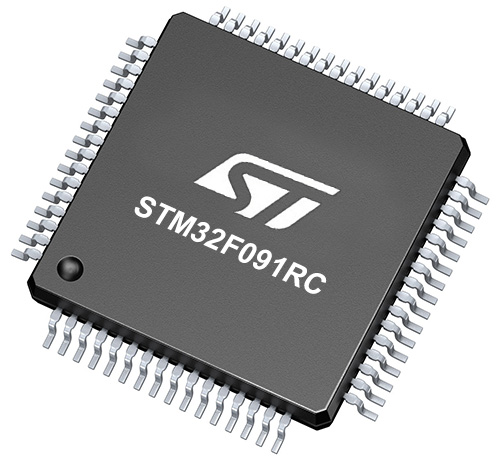
Architecture
ARM Cortex-M0
MCU Memory (KB)
256
Silicon Vendor
STMicroelectronics
Pin count
64
RAM (Bytes)
32768
You complete me!
Accessories
Click Shield for Nucleo-64 comes equipped with two proprietary mikroBUS™ sockets, allowing all the Click board™ devices to be interfaced with the STM32 Nucleo-64 board with no effort. This way, Mikroe allows its users to add any functionality from our ever-growing range of Click boards™, such as WiFi, GSM, GPS, Bluetooth, ZigBee, environmental sensors, LEDs, speech recognition, motor control, movement sensors, and many more. More than 1537 Click boards™, which can be stacked and integrated, are at your disposal. The STM32 Nucleo-64 boards are based on the microcontrollers in 64-pin packages, a 32-bit MCU with an ARM Cortex M4 processor operating at 84MHz, 512Kb Flash, and 96KB SRAM, divided into two regions where the top section represents the ST-Link/V2 debugger and programmer while the bottom section of the board is an actual development board. These boards are controlled and powered conveniently through a USB connection to program and efficiently debug the Nucleo-64 board out of the box, with an additional USB cable connected to the USB mini port on the board. Most of the STM32 microcontroller pins are brought to the IO pins on the left and right edge of the board, which are then connected to two existing mikroBUS™ sockets. This Click Shield also has several switches that perform functions such as selecting the logic levels of analog signals on mikroBUS™ sockets and selecting logic voltage levels of the mikroBUS™ sockets themselves. Besides, the user is offered the possibility of using any Click board™ with the help of existing bidirectional level-shifting voltage translators, regardless of whether the Click board™ operates at a 3.3V or 5V logic voltage level. Once you connect the STM32 Nucleo-64 board with our Click Shield for Nucleo-64, you can access hundreds of Click boards™, working with 3.3V or 5V logic voltage levels.
Used MCU Pins
mikroBUS™ mapper
Take a closer look
Click board™ Schematic

Step by step
Project assembly
Software Support
Library Description
This library contains API for Moisture Click driver.
Key functions:
moisture_get_data- Measurement data functionmoisture_cfg- Configure device functionmoisture_soft_reset- Soft reset function
Open Source
Code example
The complete application code and a ready-to-use project are available through the NECTO Studio Package Manager for direct installation in the NECTO Studio. The application code can also be found on the MIKROE GitHub account.
/*!
* \file
* \brief Moisture Click example
*
* # Description
* The demo application displays relative moisture measurement using Moisture Click.
*
* The demo application is composed of two sections :
*
* ## Application Init
* Initializes Driver and sets moisture gain, offset data and clock divider
* and performs calibration of the device. We advise you not to touch,
* or expose sensor to moisture during the calibration.
*
* ## Application Task
* The device measure moisture and displays data in percentage every 500ms.
*
* \author Jovan Stajkovic
*
*/
// ------------------------------------------------------------------- INCLUDES
#include "board.h"
#include "log.h"
#include "moisture.h"
// ------------------------------------------------------------------ VARIABLES
static moisture_t moisture;
static log_t logger;
static uint8_t moisture_data;
static uint16_t data_res;
// ------------------------------------------------------ APPLICATION FUNCTIONS
void application_init ( void )
{
log_cfg_t log_cfg;
moisture_cfg_t cfg;
/**
* Logger initialization.
* Default baud rate: 115200
* Default log level: LOG_LEVEL_DEBUG
* @note If USB_UART_RX and USB_UART_TX
* are defined as HAL_PIN_NC, you will
* need to define them manually for log to work.
* See @b LOG_MAP_USB_UART macro definition for detailed explanation.
*/
LOG_MAP_USB_UART( log_cfg );
log_init( &logger, &log_cfg );
log_info( &logger, "---- Application Init ----" );
// Click initialization.
moisture_cfg_setup( &cfg );
MOISTURE_MAP_MIKROBUS( cfg, MIKROBUS_1 );
moisture_init( &moisture, &cfg );
moisture_soft_reset( &moisture );
Delay_ms ( 1000 );
data_res = moisture_read_word( &moisture, MOISTURE_REG_DEVICE_ID );
if ( ( data_res != MOISTURE_FDC2112_ID ) && ( data_res != MOISTURE_FDC2212_ID ) )
{
log_printf( &logger, "---- Comunication ERROR!!! ---- \r\n" );
for ( ; ; );
}
else
{
log_printf( &logger, "---- Comunication OK!!! ---- \r\n" );
}
moisture_cfg( &moisture, MOISTURE_OUTPUT_GAIN_x16, MOISTURE_DEFAULT_OFFSET, MOISTURE_CLOCK_DIVIDERS_x10 );
moisture_default_cfg( &moisture );
log_printf( &logger, " --- Calibration start --- \r\n" );
moisture_cal( &moisture );
Delay_ms ( 1000 );
log_printf( &logger, " --- Calibration finishing --- \r\n" );
}
void application_task ( void )
{
moisture_data = moisture_get_data( &moisture );
log_printf( &logger, " Moisture data : %d \r\n", (int16_t)moisture_data );
Delay_ms ( 500 );
}
int main ( void )
{
/* Do not remove this line or clock might not be set correctly. */
#ifdef PREINIT_SUPPORTED
preinit();
#endif
application_init( );
for ( ; ; )
{
application_task( );
}
return 0;
}
// ------------------------------------------------------------------------ END
Additional Support
Resources
Category:Temperature & humidity




















